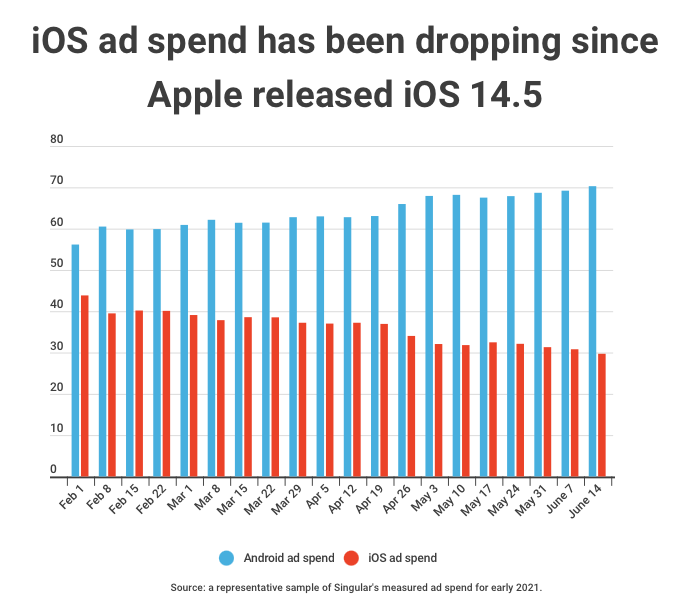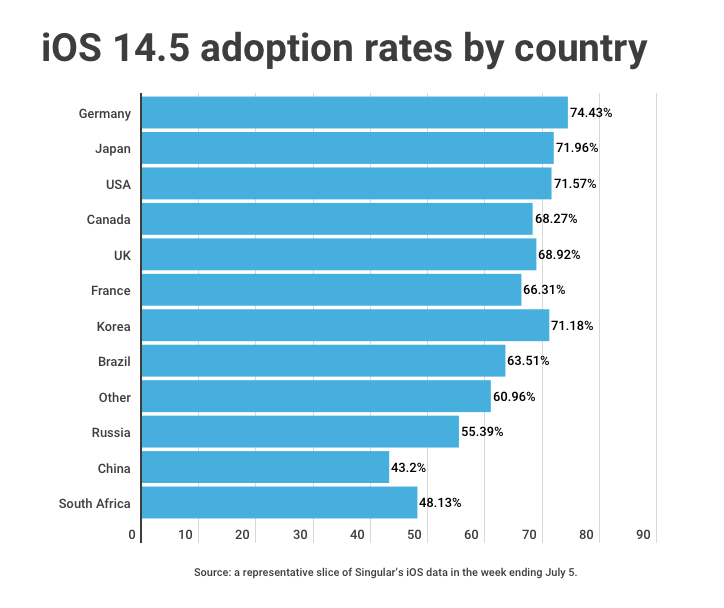SKAdNetwork impact: Android ad spend, ATT opt-in rates, ad network growth, and iOS 14.5 adoption
Mobile ad spend is in a chaotic state right now.
Android is increasingly growing mobile app install ad spend over iOS as iOS 14.5 adoption hits mainstream. Meanwhile ATT adoption is slowly increasing as the late majority updates their phones and tablets, and ad networks that took the IDFA apocalypse seriously and prepared well in advance for the massive changes that iOS 14.5 and SKAdNetwork brought are growing market share significantly.
We’ve been reporting regularly on the changes iOS 14.5 and SKAdNetwork have been driving in the mobile industry. Check the recent stories in the series if you haven’t seen them already:
- iOS 14.5 is driving ad spend to Android
- iOS 14.5: ATT permission, spend trends, and install volume
- IDFA opt-in and iOS 14.5 adoption
Android vs iOS ad spend trend continues
As we reported last week, the changes and uncertainties of iOS 14.5 and SKAdNetwork have driven ad spend to Android, causing spend on iOS to drop. That trend is continuing into late June.

In the last two weeks of June, that trendline just extended. iOS has lost another percent of total ad spend to Android from June 14 to early July. The pace of change has declined, so it’s not hard to imagine this trend stopping and even reversing somewhat over the next month as mobile growth experts get their SKAdNetwork feet under their legs and reinvest in iOS.
Mobile spend is somewhat chaotic at the moment — there’s even panic in the space, according to some industry analysts — leading to fairly erratic choices that might not be 100% data driven.
iOS 14.5 adoption: now at mainstream
iOS 14.5 is now basically mainstream, as nearly three quarters of Apple mobile devices are updated to 14.5 or later.
And that means that most of the impact that iOS 14.5 and subsequent iOS releases will have on the industry is already happening now. While we’re not yet at the 90% level, almost 70% of people globally have updated their iOS devices to iOS 14.5 or higher.
(I’m currently on iOS 14.7 on the iOS beta program.)

The U.S, Germany, and Japan are all above that level, China, Russia, and South Africa are lagging a little. Some of that lag is likely due to older devices that cannot update to the latest operating system; others due to people who are specifically ignoring updates.
(One note: if you happen to notice that at just over 43% China appears to have barely progressed from the just under 42% we last reported, you’re not nuts. Since this data is based on the OS version reported during an app install, it’s possible that even in sample sizes of millions of installs per country we could get a segment that isn’t 100% representative. It’s definitely directionally close, but if early adopters don’t regularly add more apps, the data could under-report them.)
App Tracking Transparency opt-in rates: slightly up
ATT acceptance rates are slightly higher in the past few weeks. Last time we reported, on June 23, App Tracking Transparency acceptance rates were at 23.64% globally, on average. This past week’s data indicates that ATT opt-in is now at 26% globally.
We’re now seeing the late majority and even laggards update their devices, so it’s not surprising to see that they might have slightly different preferences and habits. Ultimately, however, these levels are nowhere near where mobile marketers would like them to be if the IDFA was going to keep its primary position as a tracker and identifier for measurement purposes.
There are definitely some countries where optimizing at least some of your mobile marketing performance via IDFA is still very much an option. With 30% and up opt-in rates in South Africa, France, Korea, and over 40% in Brazil, this data can still be useful.
The U.S., Germany, and Canada, however, are in the 20% club. Given that you need IDFA opt-in from both the app advertising your app and your own app to enable full measurability, 5-10% of your installs might have IDFA. That’s nothing to sneeze at or ignore … it can be at least one indicator for optimization.
But clearly it is no longer definitive. The IDFA is now one of multiple signals in a more complex data environment that mobile growth marketers need to take into account in order to understand performance and optimize for future growth.
Ad networks with growth in SKAdNetwork
SKAdNetwork has been good for some ad networks that worked hard to prepare for the IDFA apocalypse. Among the gainers: Vungle, Liftoff, Applovin, IronSource, and Unity. Some platforms were also up, including Twitter and TikTok.
While some of that might be due to chaos in the space and spend flailing around looking for a place to land, there’s a clear correlation between ad networks that spent time and effort and money preparing for iOS 14.5 — and publicizing the fact — and those who are gaining.
One company SKAdNetwork was good for?
Apple.
Apple Search Ads saw a huge bump immediately following the launch of iOS 14.5. Its percentage of app install ad spend almost doubled week over week. But … it’s a mistake to attribute all of this to iOS 14.5, however, as Apple also released a new placement at the top of search results at nearly the same time, and advertisers probably wanted to give this a try. In about a month, however, that growth reversed itself somewhat, and in the most recent week ASA is up about 20% after adding almost two percentage points of global spend.
One thing we know: SKAdNetwork isn’t good news for all smaller players.
It is interesting and important to note that the flight to mid-tier networks didn’t — at least yet — include third-tier players: the smaller ad networks with less of a footprint and fewer clients. While we’ve often seen at Singular they produce good ROI, they’re simply not as well known or understood. And in some cases they may lack the capacity to soak up additional billions of requested ad placements in literally days or weeks.
More data coming soon: connect to get it direct
We are releasing data regularly on the impact of iOS 14.5. Sign up for updates to our blog here (scroll down to subscribe.) Then make sure you drag the email to your priority in-box to ensure you see it regularly.
And, if you need next-generation marketing measurement support, book some time with Singular. We’ll listen, learn, and suggest some options that are working well for others.
Stay up to date on the latest happenings in digital marketing


